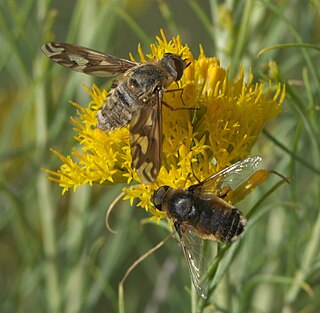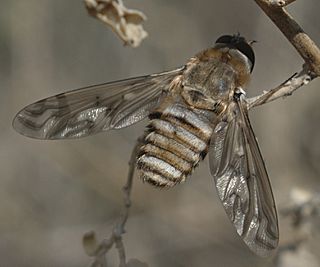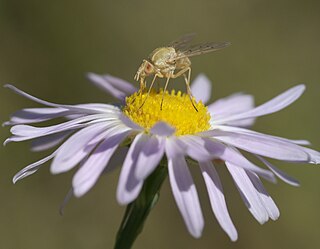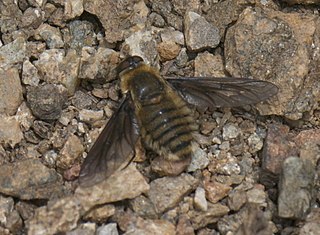
The Bombyliidae are a family of flies, commonly known as bee flies. Some are colloquially known as bomber flies. Adults generally feed on nectar and pollen, some being important pollinators. Larvae are mostly parasitoids of other insects.

Poecilanthrax willistoni, Williston's bee fly or sand dune bee fly, is a member of the Bombyliidae insect family. This family includes the bee flies, true flies that have developed Batesian mimicry characteristics to avoid predators. That is, they look like bees because that helps them avoid bee-wary predators, but they lack stingers.

Poecilanthrax is a large, primarily Nearctic genus of flies belonging to the family Bombyliidae.

Anthracinae is a subfamily of bee flies in the family Bombyliidae. There are more than 80 genera and 2,000 described species in Anthracinae.

Toxophorinae is a subfamily of bee flies in the family Bombyliidae. There are about 7 genera and more than 400 described species in Toxophorinae.
Dicranoclista is a genus of bee flies in the family Bombyliidae. There are at least two described species in Dicranoclista.
Aphoebantus conurus is a species of bee flies in the family Bombyliidae.
Bombylius albicapillus is a species of bee fly in the family Bombyliidae. It occurs in western North America.

Lordotus pulchrissimus is a species of bee fly in the taxonomic order Diptera and family Bombyliidae. It is also frequently referred to as the desert bee fly. Few studies have been done on the biology of L. pulchrissimus, although their behavior in the wild has been observed.

Lordotus is a genus of bee flies. There are at least 30 described species in Lordotus.
Poecilognathus punctipennis is a species of bee flies.

Poecilognathus is a genus of bee flies. There are at least 20 described species in Poecilognathus.

Phthiriinae is a subfamily of bee flies in the family Bombyliidae. There are about 11 genera and more than 120 described species in Phthiriinae.
Exoprosopa parda is a species of bee fly in the family Bombyliidae.

Poecilanthrax monticola is a species of bee fly in the family Bombyliidae. It is found in North America, from British Columbia and Alberta south to Nebraska, Utah, and Colorado.

Villini is a tribe of bee flies in the family Bombyliidae.

Thevenetimyia luctifera is a species of bee flies, insects in the family Bombyliidae.

Thevenetimyia speciosa is a species of bee flies, insects in the family Bombyliidae.
Usiinae is a subfamily of bee flies in the family Bombyliidae. There are at least 3 genera and 180 described species in Usiinae.

Lomatiinae is a subfamily of bee flies in the family Bombyliidae. There are about 16 genera and at least 290 described species in Lomatiinae.














